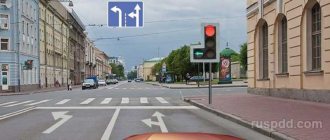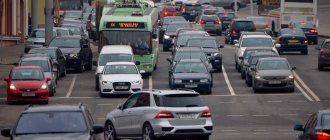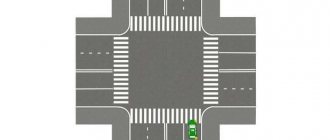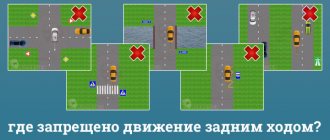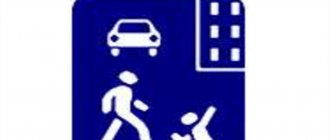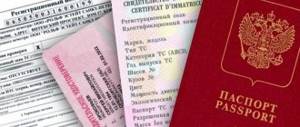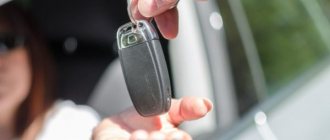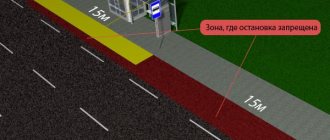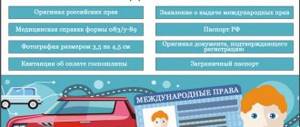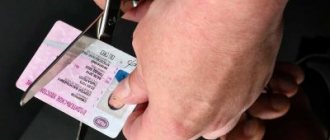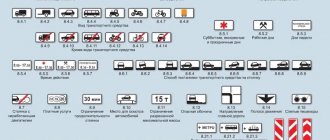Sign 5.15.2 “Lane directions”
Sign 5.15.2 “Driving directions along the lane” indicates the number of lanes and the permitted directions of movement along each of them.
The only difference between signs 5.15.1 and 5.15.2 is that the first signs look combined, and the second ones look separate, for each of the lanes. The function of these signs is the same.
Road signs 5.15.1 “Driving directions along the lanes” and 5.15.2 “Driving directions along the lane” are used to indicate the permitted directions of movement along each of the lanes at an intersection when it is necessary to ensure the use of lanes in accordance with the intensity of vehicle traffic in various directions.
Signs 5.15.1 and 5.15.2, which permit a left turn from the extreme left lane, also permit a U-turn from this lane. But before you turn around, you should make sure that turning around is not prohibited by sign 3.19.
The effect of signs 5.15.1 and 5.15.2 installed in front of the intersection extends to the intersection, unless signs 5.15.1 or 5.15.2 installed directly at the intersection provide other instructions. I recommend reading the series of articles Navigating intersections and the article Changing lanes (changing lanes) at an intersection.
These signs do not apply to route vehicles.
Drivers of route vehicles have the right to deviate from the requirements of the “Lane Directions” signs. This right is explained by the specific directions of the routes. In addition, public transport stops are located on the right side of the road. I recommend the article Driving past a bus stop.
Lane direction signs are installed above the roadway at a noticeable distance from the intersection so that drivers have the opportunity to make the necessary lane changes in a timely manner.
Sign 5.15.1 (combined) is placed above the middle of the roadway in this direction. Each of the signs 5.15.2 (separate) is placed above the middle of the strip for which it is intended.
On wide roads, in addition to being located directly at intersections, “Lane Directions” signs are also installed in advance. If there are up to three lanes in front of the intersection for a given direction, then either sign 5.15.1 (combined) or signs 5.15.2 (separate) can be installed in advance.
If there are three or more lanes for traffic in a given direction in front of the intersection, then signs 5.15.2 will first be installed above each lane. On other roads with fewer lanes, preliminary signs are installed as necessary.
Preliminary signs 5.15.1 and 5.15.2 are placed at a distance of 50 - 150 meters from the installation site of the main signs.
On roads with no more than two lanes for traffic in one direction, sign 5.15.1 (combined) may be placed not above the roadway, but to the right of the road, and a preliminary sign 5.15.1 is also installed.
If signs 5.15.1 and 5.15.2 are present, signs 4.1.1 - 4.1.6 are not used.
In which directions are you allowed to continue driving?
| 1. | Only to the left. |
| 2. | Straight and left. |
| 3. | To the left and in the opposite direction. |
An additional section with a signal turned on in the form of a green arrow, a sign “Driving directions along the lanes” and markings 1.18 allow you to only turn left from the right lane. Traffic is directly prohibited by a red traffic light, and turning is prohibited, since the rules require turning only from the leftmost lane. Turning right is prohibited at any signal.
Sign 5.15.7 “Direction of traffic along lanes”
Sign 5.15.7 “Direction of traffic along the lanes” is used to indicate the number of lanes and the direction of traffic along them, when the number of lanes in a given direction is greater than in the oncoming direction. The sign is installed BEHIND every intersection on a section of road with such traffic organization.
If sign 5.15.7 on one of the lanes shows another sign prohibiting the movement of any vehicles, then the movement of these vehicles in the corresponding lane is prohibited. Later, the same prohibitory sign with the sign 8.14 “Traffic Lane” will be located above this lane.
It is allowed to install a sign with two arrows (two arrows: forward and two: forward and towards) on sections of two-lane roads (roadways) when the organization of one-way or two-way traffic may be perceived ambiguously by drivers.
The sign may be used to organize reverse traffic. In this case, the sign is installed behind each intersection along the entire section of the road.
Which trajectory do the Rules allow you to make a left turn?
| 1. | Only according to A. |
| 2. | Only according to B. |
| 3. | For any reason. |
The “Lane Directions” sign allows for left turns at this intersection from the middle and left lanes. Therefore, you can turn left either by moving into the leftmost lane in advance, or by continuing in the middle lane, i.e. turning is allowed along any of the specified trajectories.
Sign 5.15.8 “Number of lanes”
Sign 5.15.8 “Number of lanes” is used to indicate the number of lanes in a given direction and traffic modes along the lanes.
The “Number of Lanes” sign is installed in populated areas - at a distance of 50 - 150 meters, and outside populated areas at a distance of 150 - 300 meters from the beginning of the road section, on which lane traffic modes are introduced by appropriate signs with signs 8.14 "Traffic Lane".
Sign 5.15.8 is installed above the roadway. Outside populated areas, on roads that have no more than three lanes before an intersection, and in populated areas no more than two lanes in a given direction, the “Number of Lanes” sign can be installed to the right of the road.
In which directions are you allowed to continue driving?
| 1. | Only to the left. |
| 2. | Only in the opposite direction. |
| 3. | To the left and in the opposite direction. |
An additional section with a green arrow signal on, a “Lane Directions” sign and marking 1.18 allow you to turn left or make a U-turn from the left lane.
What should you do if you were driving in the left lane and stopped by a traffic police officer?
Despite the provided liability, it is extremely problematic to be held accountable for driving in the left lane on a section of the road where it is prohibited unless necessary. Inspectors will have to prove that the driver violated traffic rules. He, in turn, can explain driving on the left as follows:
- the right lane was occupied by another car traveling at a lower speed, and it was necessary to get ahead of it;
- There was an obstacle in the right lane that we had to go around: a hole, a pothole, an accident.
Most often, drivers explain driving in the left lane by looking for a left turn. Inspectors have no right to punish for this. If the protocol is nevertheless drawn up, you need to make a note of disagreement on it and indicate the reasons. After this, the protocol can be challenged through the court or the head of the traffic police.
Contradictions between signs and markings
Sometimes drivers make the wrong decision due to conflicting signs and markings.
How to move along the lanes correctly so as not to get a fine? Tips from a driving instructor in this video:
For a better understanding, it is recommended to consider the following cases:
- Detour into the oncoming traffic section of the roadway being repaired;
- Overtaking when setting markings 1.1 and sign 3.21;
- Overtaking when setting markings 1.5 and sign 3.2.
Every year there is a tendency to tighten traffic regulations. This is a necessary measure.
Every road user is required to follow the described rules. Otherwise, this may lead to emergency situations on the road.
Fines for violations
For traffic violations and when these violations are legally established by traffic police officers, drivers are subject to administrative liability:
| Violation | Amount of fine, rub. |
| Vehicle movement along the dividing strip (incorrect location of vehicles on the road) | 1500 |
| Crossing a “solid” road when entering a dividing strip | 500 |
| Changing lanes without warning signals | 500 |
| Turning from a lane prohibiting this maneuver | 1500 |
| Driving in oncoming traffic to avoid obstacles | 1000 – 1500 |
| Driving into oncoming traffic to overtake | 5000 |
| Deprivation of rights for 4 – 6 months. | |
| Deprivation of rights for 1 year if the offense is committed repeatedly | |
| If a repeated violation is detected by automatic means, the fine is 5000 | |
| Use of the bicycle lane by motor vehicles | 2000 |
| Driving in a dedicated lane | 1500 (for Moscow and St. Petersburg – 3000) |
| Violation of the traffic mode established for the lane | A fine similar to that for violating the speed limit |
Responsibility for failure to comply with the rules when driving in lanes is severe, including loss of rights. Reminding us that we create security for life ourselves seems banal. After all, you already understand everything, right?
The effect of a stop prohibited sign is explained in the article: stopping is prohibited according to traffic rules. For instructions from traffic controllers, see the page.
Find out what changes have occurred when transporting children in a car according to traffic rules in 2021 from this information.
Features of driving in the oncoming lane
Driving in the oncoming lane is undesirable, but in some circumstances it is possible and necessary. To avoid trouble in this dangerous area, you should:
- When turning and crossing roads, the car should not end up in oncoming traffic; this will be regarded as a violation, regardless of the number of lanes and type of markings.
- When overtaking is carried out on a two-way road with four or more lanes, passing in the oncoming lane is unacceptable.
- It is allowed to enter oncoming traffic if you need to perform one of the maneuvers: overtaking, turning around, going around an obstacle, turning left. In this case, the road should be three-lane, and its middle part should be intended for traffic in two directions.
- If the road is narrow and has no dividing markings, you can drive into the oncoming lane to overtake, provided there are no prohibiting signs nearby.
At the crossroads
There are special requirements for crossing intersections:
- If lane indicators are not installed and there are no markings on the roadway, when turning, you must stand in the appropriate lane. Those who plan to drive straight can choose any lane.
- If there are lane signs but no lane markings, you need to follow the signs and move according to where you need to go after the intersection.
- If there is a 1.8 dividing marking, you need to find your lane and move along it. Each row is marked with an arrow indicating permitted movement. If you can turn left, a U-turn is also allowed.
- In a situation where there are signs and markings at an intersection that have conflicting information, you should rely on the sign: it has priority.
When changing lanes
If you need to maneuver in lanes or before an intersection, you need to remember these rules:
- If a motorist was moving straight and intends to continue moving that way, the driver who wants to turn and therefore changes lanes is obliged to let him pass.
- In the event that drivers simultaneously intend to make a maneuver, the one who occupies the position on the right has priority.
For traffic safety, it is necessary to turn on the turn signal in advance, select the correct speed and do not forget about the mirrors.
These instructions apply to driving on any road, regardless of the presence of markings. It is worth remembering: if there are no dividing stripes, then the number of directions will always be even.
On a road with a reversible lane
There are no special signs indicating that there is a reversible lane on the roadway. There is a sign 5.8 indicating reverse traffic on the road, and a sign 5.10 indicating that there will soon be an intersection with a road with reverse traffic.
Reversing traffic lights also have nothing to do with lane designation. They regulate the movement of transport rows.
Reversing lanes are indicated by dividing markings 1.9. If there is one, there are, respectively, two stripes. If there are several markings on the canvas, then there will be as many reverse stripes as the number of stripes that have corresponding boundaries.
If the traffic light is not functioning or it simply does not exist, it is allowed to cross the reverse line if it is to the right of the driver. If there are reverse boundaries on both sides, you cannot enter such a lane.
What is allowed when starting a roundabout?
Based on traffic rules 8.5, you can enter the circle from any lane. There is one peculiarity in the roundabout: entry is allowed into the lane where the driver was before the start of the circle.
For example, it is prohibited to enter the left lane of a roundabout from the right lane of the roadway.
